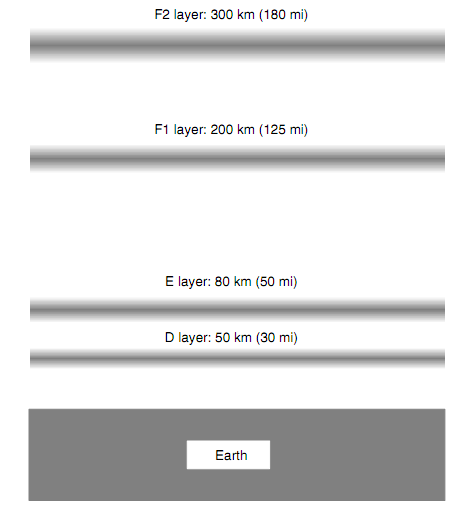RF Waves:
The EM disturbance is termed as a radio-frequency (rf) wave when its wavelength falls in the range of 100 km to 1 mm. It is a frequency range of 3 kHz to 3000 GHz.
EARTH'S IONOSPHERE:
The environment of our planet becomes less dense with rising altitude. Since of this, the energy received from the Sun is very much greater at high altitudes than it is at the surface. The high-speed subatomic particles, x-rays, and UV rays cause ionization of the rarefied gases in the upper environment. Ionized areas take place at particular altitudes and comprise the ionosphere. The ionosphere causes refraction and absorption of radio waves. This builds long-distance communication or reception possible at few radio frequencies.
Ionization in the upper environment takes place in four fuzzy layers. The lowest area is termed as the D layer. It exists at an altitude of around 50 km (i.e., 30 mi) and ordinarily is present only on the daytime side of the planet. This layer does not share to long-distance radio communications, and at times obstructs them. The E layer, around 80 km (i.e., 50 mi) above the surface, also exists mostly during the day, however nighttime ionization is at times noticed. The E layer can facilitate medium-range radio communications at assured frequencies. The uppermost layers are termed as the F1 layer and the F2 layer. The F1 layer, generally present only on the daytime side of the Earth, forms at around 200 km (i.e., 125 mi) altitude. The F2 layer, that exists more or less around the clock, is around 300 km (i.e., 180 mi) above the surface. On the dark side of the Earth, whenever the F1 layer vanishes, the F2 layer is at times termed simply the F layer.
The figure below explains the relative altitudes of the ionospheric D, E, F1, and F2 layers over the Earth's surface. All such layers have some effect on the way radio waves travel at very low, low, medium, & high frequencies. At times, ionospheric effects can even be examined into the VHF part of the radio spectrum. Such layers not only make long-distance wireless communications possible among points on the Earth's surface; they also prevent radio waves at frequencies below around 5 MHz from reaching the surface from outer space.

Figure: Layers of the Earth's ionosphere. Such ionized areas affect the behavior of EM waves at some radio frequencies.